OPB’s “Superabundant” explores the stories behind the foods of the Pacific Northwest with videos, articles and this weekly newsletter. To keep you sated between episodes, we’ve brought on food writer Heather Arndt Anderson, a Portland-based culinary historian and ecologist, to highlight different aspects of the region’s food ecosystem. This week she’s besotted to share a brand new episode of “Superabundant”: Chardonnay.
Click here to subscribe. For past issues, go here.

opb / OPB
If pinot noir is the king of Oregon wines, then chardonnay is the queen. It wasn’t an easy run to the throne, though; it took decades to find the right mix of techniques, locations — and vines — to make chardonnay work in Oregon, but in 2022 Wine Spectator’s highest-ranking Oregon wine was a chardonnay. Why did clones from Dijon, France, ultimately make the cut? Read on to find out!
Sickening strawberries, eating more sushi for a good cause, and making it official with potatoes
Freshly picked morsels from the Pacific Northwest food universe:
A berry scary hepatitis A outbreak hits the Northwest
Five people in Washington got sick after eating frozen strawberries, NPR reported last week. The berries, sold at Costco, Aldi and Trader Joe’s, likely came from a grower in Baja, California, in Mexico, which is all the more reason to buy locally grown strawberries. That said, Japanese strawberry growers, in their quest for the earliest fresh and local berries possible, have taken to heating greenhouses with kerosene, reports the New York Times. This comes with an obvious trade-off: berries grown in climate-controlled greenhouses are still technically local (requiring less fuel to distribute to retail markets) and require less land and pesticides to produce than field-grown berries, but burning that much kerosene is costly both to farmers and the environment.
In case uni-d a reason to eat more sea urchin
A recent study published by researchers from Oregon State University, University of Oregon and the Nature Conservancy has revealed that the sunflower sea star (Pycnopodia helianthoides) plays a key role in maintaining kelp forests in the Pacific Ocean. Namely, they eat the sea urchins that graze the kelp. Unfortunately, in 2020 sunflower sea stars were listed as critically endangered by the International Union for Conservation of Nature, following a study that revealed the devastating effects of sea star wasting syndrome. This, in turn, led to an explosion in the sea urchin population, which ruins it for everyone, since kelp forests are a key marine habitat. However, there is something we can do to help the kelp — sea urchin roe (aka uni) happens to be a Japanese delicacy. (Don’t worry, there’s also a recovery plan for the sunflower sea stars.)
Watch the Sea Urchin episode of “Superabundant”
An a-peel to make the potato Oregon’s official state vegetable
The Oregon Senate recently passed a resolution (in a unanimous 29-0 vote!) to officially designate the potato as Oregon’s state vegetable; the bill now heads to the Oregon House. Making a case for the designation was easy: Not only is Oregon the birthplace of the tater tot (and totcho, as previously reported by this newsletter’s author), but the frozen hash brown patty made famous by the McDonald’s breakfast menu was also first produced by Ore-Ida — and predates the tot. Waffle fries were invented by another Oregon frozen foods company, Lamb Weston (they also invented the water gun knife that speedily cuts French fries by hydro-blasting them through a sharp grid). There’s also a strong argument that Oregon created the jojo, so at this point we’re wondering what Idaho even has to say for themselves.
New video: Chardonnay
Though chardonnay grapes have been grown in Oregon since the 1960s, it wasn’t until Oregon winemakers started to explore different chardonnay clones, brought from Dijon, France — a region ecologically more similar to Oregon than to California — that vintners found a consistent winner. These clones had smaller berries and ripened faster, making them a much better fit for Oregon’s shorter growing season.
Because of the similarities to the original French grapes, the wine created from this fruit makes a superb pairing to other Oregon ingredients with French inclinations. Think truffles, hazelnuts, cheeses, and seafood. The main difference between Oregon chardonnay and say, California, is that the Oregon-produced version tends to be less buttery and more crisp, even if it’s aged in local oak instead of steel casks.
In this episode of “Superabundant,” with special guest guide Chevonne Ball, we talk to the people who grow and pick the grapes — the stewards of the vineyards — and to the people who turn those grapes into award-winning chardonnays.

Sablefish is also known as black cod.
Heather Arndt Anderson / OPB
Recipe: Sablefish with sauce vin blanc
Like Oregon’s chardonnay, sablefish (better known as black cod) doesn’t always get the recognition it deserves — but that’s beginning to change. This versatile, succulent white fish dwells on the ocean floor along the continental shelf on the Oregon and Washington coasts (and the rest of the West Coast). Because of the regulations put in place to manage the fishery, it’s a great choice for piscivores who keep an eye on sustainability. Here we’ve prepared it in a classically French style: with copious amounts of butter and white wine. Serves 4.
Important note: you should never cook with wine you wouldn’t drink, so feel free to use the good stuff.
Ingredients:
4 4-oz sablefish filets, patted dry
1 tsp fine sea salt
½ tsp pepper
4 tbsp all-purpose flour
4 tbsp (½ stick) unsalted butter, preferably a higher butterfat European-style
2 tbsp minced shallots
½ cup white wine (such as a nice Oregon chardonnay)
2 tbsp minced herbs such as parsley, tarragon, or chervil
Instructions:
- Season the sablefish with salt and pepper and then dredge in the flour, shaking off the excess.
- Melt the butter in a medium skillet over medium-high heat, and when it begins to foam and spit, add the shallots and fish to the pan and reduce the heat to medium.
- Cook the fish for 3-4 minutes on each side, then transfer to a plate and keep warm. Add the wine to the pan and simmer until the sauce is glossy and reduced by about half, about 5-8 minutes. Taste and adjust seasoning as needed (it’ll probably need another pinch of salt).
- Stir in the herbs and spoon the sauce over the cooked fish.



